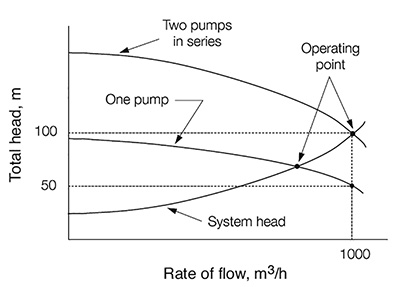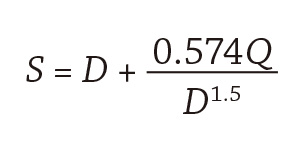Q. What specifications are required for series and parallel pump operations?
A. Pumps intended to operate in series must be close in size because of the rate of flow. Pumps operating in series produce head that is additive at the rate of flow at which they would run individually. Two pumps, each capable of 4,400 gallons per minute (gpm) (1,000 cubic meters per hour) at 165 feet (50 meters) of head, when connected in series, could deliver 4,400 gpm (1,000 cubic meters per hour) at 330 feet (100 meters) of head.
Series operation is, therefore, used when higher pressures than an individual pump can supply are required. Pumps used in series must be capable of the increased pressure levels that result from staging. For example, lower speed booster pumps can provide an increase in net positive suction head available (NPSHA) for high-pressure pumps. See Figure 1.3.6.1.2a.

Pumps for parallel operation must be close in total head developed. Otherwise, one or more of the pumps may be forced to operate at shut-off or at unacceptably low flows. Pumps operating in parallel produce a rate of flow that is additive at the head at which they would run individually. Two pumps, each capable of 2,640 gpm (600 cubic meters per hour) at 115 feet (35 meters) of head, when connected in parallel could deliver 5,280 gpm (1,200 cubic meters per hour) at 115 feet (35 meters) of head. See Figure 1.3.6.1.2b.

In such cases, the system curve will determine the final operation point. Two pumps operating in parallel will not automatically deliver twice the flow of one pump. For more on multiple pump performance, see ANSI/HI 1.3 Rotodynamic Centrifugal Pumps for Design and Application.
Q. What is the simplest way to determine the minimum submergence required for a large vertical turbine pump to prevent the formation of surface vortices and the entrance of air into the pump?
A. This answer provides the recommended minimum submergence of a vertical pump inlet bell to reduce the probability that strong free-surface air core vortices will occur. Submerged vortices are not believed to be related to submergence. If a submergence greater than recommended here is needed to provide the net positive suction head required (NPSHR) for the pump, the greater submergence should be used.
Approach-flow skewness and the resulting circulation have a controlling influence on free surface vortices despite adequate submergence. The recommended minimum submergence provided in this column is for a reasonably uniform approach flow to the pump suction bell. Highly non-uniform approach flows require vortex suppression devices.
Experimental analysis and field experience have resulted in the following empirical relationship:

Where:
S = submergence in inches
D = bell diameter in inches
Q = rate of flow in gpm
For more on submergence, see ANSI/HI 9.8 Rotodynamic Pumps for Pump Intake Design.
Q. What effects are seen when operating a pump outside the AOR?
A. One example of an effect that occurs when operating a pump outside the allowable operating region (AOR) is noise, which is expected from any pump. Pumps with higher energy levels usually operate with higher noise levels.
At higher and lower rates of flow and lower net positive suction head margins, noise often changes from a sound similar to sand sliding down a chute to one of gravel or rocks. The change is often not distinguishable on a sound level meter, but the change in sound characteristic is detectable by the human ear. Gravel and rock sounds are usually caused by cavitation in the pump, which may cause mechanical damage and can limit the AOR.
Some relief from the noise can be obtained by operating the pumps closer to the best efficiency point or replacing the noisier pumps with lower speed units. For more information on factors affecting AOR, see ANSI/HI 9.6.3 Rotodynamic (Centrifugal and Vertical) Pumps Guideline for Allowable Operating Region.

